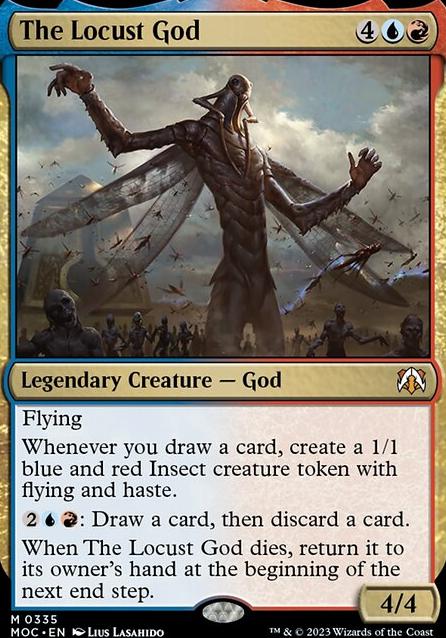
The Ten Plagues: Locust God cEDH [PRIMER]
Commander / EDH Competitive Infinite Combo Primer Tokens UR (Izzet) Vorthos
Land (32)
- 1x Academy Ruins
-
1x
Ancient Tomb

- 1x Bloodstained Mire
-
1x
Cascade Bluffs

- 1x Cavern of Souls
-
1x
Cephalid Coliseum

-
1x
City of Brass

-
1x
Command Beacon

-
1x
Command Tower

-
1x
Exotic Orchard

- 1x Flooded Strand
-
1x
Inventors' Fair

-
8x
Island

-
1x
Mana Confluence

-
4x
Mountain

- 1x Polluted Delta
-
1x
Shivan Reef


-
1x
Spirebluff Canal

-
1x
Steam Vents

-
1x
Strip Mine

-
1x
Sulfur Falls

- 1x Wooded Foothills
Creature (7)
-
1x
Consecrated Sphinx

-
1x
Jace's Archivist

-
1x
Kozilek, Butcher of Truth

-
1x
Simian Spirit Guide


-
1x
Spellseeker


-
1x
Trinket Mage


-
1x
Whirlpool Warrior


Enchantment (7)
Instant (19)
-
1x
Abrade

-
1x
Arcane Denial

-
1x
Brainstorm

-
1x
Counterspell

-
1x
Cyclonic Rift


-
1x
Dramatic Reversal

-
1x
Firestorm

- 1x Force of Will
-
1x
Frantic Search

-
1x
Impulse

-
1x
Izzet Charm


-
1x
Mana Drain

-
1x
Muddle the Mixture

-
1x
Mystical Tutor

-
1x
Pact of Negation

- 1x Paradoxical Outcome
-
1x
Stifle

-
1x
Swan Song


-
1x
Whir of Invention

Sorcery (15)
Commander (1)
Artifact (18)
-
1x
Ashnod's Altar

-
1x
Chrome Mox

-
1x
Coalition Relic

-
1x
Coldsteel Heart

-
1x
Fellwar Stone


-
1x
Gilded Lotus

- 1x Grim Monolith
-
1x
Isochron Scepter

-
1x
Izzet Signet

-
1x
Lotus Petal

-
1x
Mana Crypt

-
1x
Mana Vault

-
1x
Mox Diamond

-
1x
Mox Opal

-
1x
Phyrexian Altar

-
1x
Relic of Progenitus

-
1x
Skullclamp

-
1x
Sol Ring

Planeswalker (1)
Sideboard
Maybeboard
Artifact (6)
Creature (3)
Instant (3)
Land (3)
Sorcery (2)
Suggestions
Updates Add
Comments View Archive
Attention! Complete Comment Tutorial! This annoying message will go away once you do!
Important! Formatting tips — Comment Tutorial — markdown syntax
Please login to comment
| Top Ranked |
|
| Date added | 7 years |
| Last updated | 1 year |
| Legality | This deck is not Commander / EDH legal. |
| Rarity (main - side) | 19 - 0 Mythic Rares 41 - 0 Rares 11 - 1 Uncommons 14 - 1 Commons |
| Cards | 100 |
| Avg. CMC | 2.16 |
| Tokens | Bird 2/2 U, Emblem Dack Fayden, Insect 1/1 UR |
| Folders | Nice, EDH decks, Cool ideas, Inspiration, Interesting decks, Interesting Brews, EDH Decks to Build, primer, EDH, EDH |
| Votes | |
| Ignored suggestions | |
| Shared with | |
| Views |




